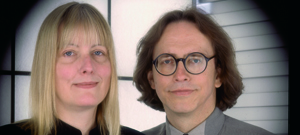Nancy Skolos (1955) and Thomas Wedell (1949) met at Cranbrook Academy of Art (Michigan, US) in the mid-1970s. Since then, their personal and professional lives have been firmly intertwined. Nancy’s typography and design and Thomas’s photography coexist in their Boston house-studio where, far from clashing, they generate new paradigms of visual communication. The passion both artists profess the creative process has sharpened their inventiveness in a series of forceful posters. Illusory spaces and three-dimensional images in caps.
Perhaps the best way to approach the work of designer Nancy Skolos and her husband, photographer Thomas Wedell, principals of Skolos-Wedell in Boston, is through the book which they have co-authored, published by Rockport, which is available at bookshops from June. Its title, Type, Image, Message: Merging Pictures and Ideas. A Graphic Design Layout Workshop, already hints at some of the aspects peculiar to their work. The reference to message, for instance, is not accidental. In an age in which authorship is often seen as mere formalism, the images (by international designers) shown here are all, without exception, interpretations of ideas. Moreover, the concept of workshop is related to their teaching activity. Skolos is head of the Department of Graphic Design at RISD (Rhode Island School of Design), the prestigious school of design and visual arts in Providence, where Wedell is also a faculty member.
Additionally, the connection between type and image is an efficient cataloguing instrument to establish four categories within this relation: separation, fusion, fragmentation (image destroys type or vice versa) and inversion (image is transformed into type or type into image). Skolos is quick to admit that fusion is probably the category that prevails in her work, to which it is possible to apply a metaphor that has been in use since the 1980s and evokes choreography. The presence of a choreographic ensemble of symbols at the basis of their designs is undeniable; it is as if this were the score (in musical terms) required to organise their dislocated spaces and reading times. Moreover, this idea bears witness to their powerful visual resources, metaphorically picking up the thread of the concept of image ‘levels’, possible today thanks to the use of graphic computer programmes. In Skolos and Wedell, however, the levels do not only overlap but dissolve into each other.
This makes their visual references all the more complex. It is true that when referring to Skolos and Wedell one tends to think of “Techno-Cubism” (and Skolos confesses to an early infatuation with Leger), but it is equally true that in their images it is possible to detect another series of influences: those of Surrealism, a certain type of Constructivism, the post-Modernism of the 1980s, the Parisian Decó of the 1930s and, why not, the Figurativism of the 1950s in evidence in the schools of Eastern Europe.
There is only one explanation for a range of references as wide as this: their having gone beyond the threshold of image and lettering. And so we return, once again, to Type, Image, Message. In effect, if we visualise the history of graphic design as a pendulum that swings between abstraction, systematisation, writing and modularity, on the one hand, and figuration, iconography and irregularity, on the other, then by the same token we must admit that the manifests and the design work executed by Skolos and Wedell ride the crest between these two tendencies.
In this light, the other category which Skolos attributes to her work – fragmentation – is interesting. It could even be related to a technological metaphor. Indeed, it should not be forgotten that Wedell is a photographer and that as such, in the practise of his professional activity, he has had ample opportunity to reflect on the way in which digitalisation has influenced what, by its very definition, is the image par excellence: photographic image.
And, obviously, Skolos will have done the same with regard to type, an area that is important part of the curriculum at RISD (Tobías Frere-Jones and Cyrus Highsmith’s alma mater). To sum up, in the work of Skolos and Wedell the pulverisation of image resulting from digitalisation does not create new spectacular, hyperrealist or super-realist effects, just as the non-linearity of the reading induced by hypertextual practices does not turn into an out-and-out succession of dramatic effects. The reader is asked to enter the picture, to discover its choreographic structure and, in this way, to access its immensely rich semantic content. What this boils down to is that the work of this Bostonian husband-and-wife team is not exactly polysemous, as one would often like works of art to be (at least in the past two centuries). Rather, it is an oeuvre that puts forth a series of meanings; these, however, are not piled up, but adequately concatenated and, consequently, capable of maintaining a unitary association between perceptive reading and semantic decoding.
Article published on Experimenta 56.

